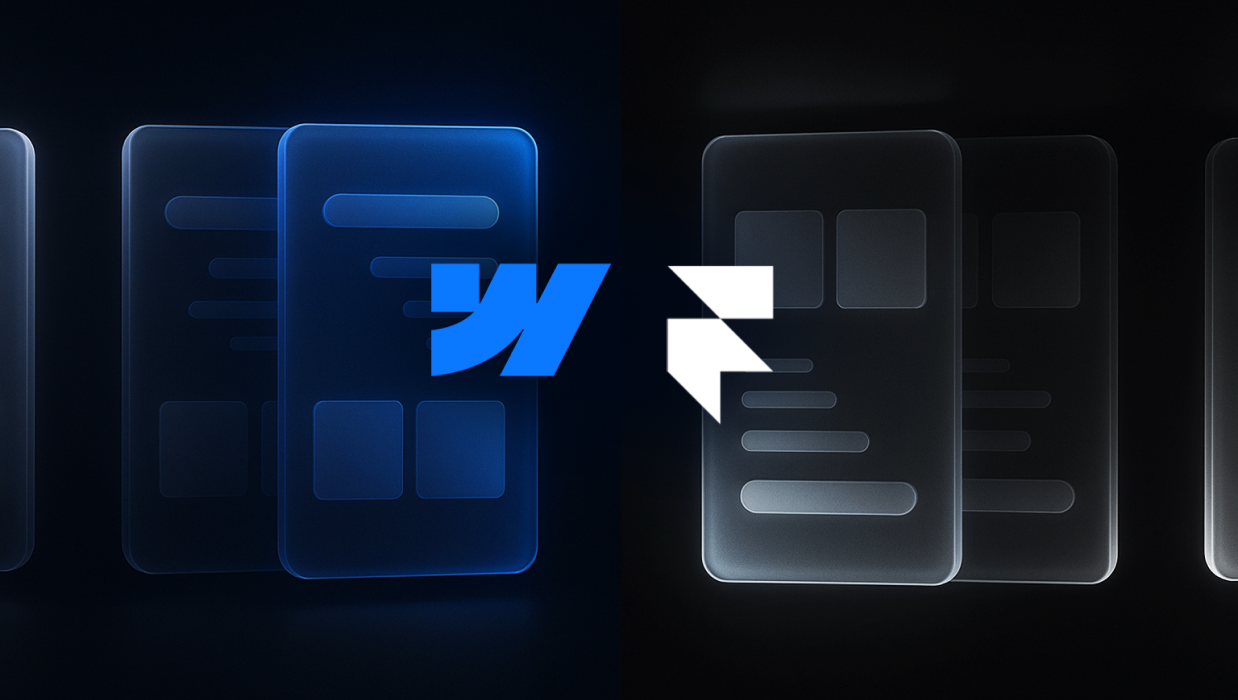
Framer vs Webflow for B2B SaaS: Which Platform Fits Your Growth Stage
Framer vs Webflow for B2B SaaS
Choosing the right platform for speed, scalability, and growth
Your website is a growth vehicle. The platform you build it on determines how fast you can launch, how easily you iterate, how tightly you integrate marketing operations, and how well you convert. At Noco, for B2B SaaS companies, we see real trade-offs between Framer and Webflow. This blog gives you the data and the decision-logic.
Framer: rapid validation, design-first simplicity
Framer’s sweet spot is getting you live quickly, looking sharp, and enabling your lean team to iterate without heavy engineering overhead.
What makes Framer attractive early on:
- Designers familiar with tools like Figma can hit the ground running. In a discussion with Leonardo and Daniel we emphasised how “prototype becomes live site” with minimal friction.
- Low dependency on full engineering resources keeps costs and time low.
- Ideal for SaaS companies in the seed/pre-Series A phase that need to test positioning, refine messaging and get to market fast.
Where you’ll hit constraints:
- Framer’s component, class and logic architecture is less mature for complex CMS structures, multiple languages, or heavy integrations. As Daniel pointed out, once your marketing stack and conversion pipelines grow, you feel the ceiling.
- If you’re planning to run extensive CRO experiments, layered personas, or deep automation from day one, you may outgrow the setup.
Bottom line for B2B SaaS:
If you need to validate story, brand, UX and market fit quickly, Framer is a strong tool. But be aware you’re choosing speed over long-term systemisation.
Webflow: systemised, scalable, built for growth
Webflow comes into its own when you’re beyond validation and building for growth, when your marketing team, conversion goals, stack complexity and A/B testing all matter.
What Webflow brings to a growth stage:
- Component-based architecture, CMS scale, design freedom and robust integrations.
- Ability to manage blogs, case studies, product pages, personas, region-specific content, automation and analytics with higher fidelity.
- Webflow respects how the web works. Its design-first approach delivers custom flexibility without compromising performance or scalability.
What to watch out for:
- Total cost and effort are higher, so for early-stage startups with limited margin it might be overkill.
- Projects require structured setup and expertise to fully leverage Webflow’s modular power.
Bottom line for B2B SaaS:
If you’re in or approaching Series A+, marketing motion is scaling, you have multiple personas, you’re integrating data and automation, Webflow is your choice.
Platform decision-matrix for B2B SaaS

At Noco we often recommend: start with Framer for message validation, then migrate to Webflow once scoring conversions, scale and automation become priorities.
Facts and figures: Framer vs Webflow
Framer
- Founded: 2014 in Amsterdam, Netherlands by Koen Bok and Jorn van Dijk. (framer.com)
- Headquarters: Amsterdam. (cbinsights.com)
- Funding and valuation: Reported as a 2 billion dollar valuation recently. (businessinsider.com)
- Business model: Design-canvas plus publishing, built for teams that want visual control, speed and output.
- Strengths: Design-first workflow, rapid time to launch, minimal engineering bottleneck, good for single-product SaaS or minimal marketing pages.
- Weaknesses: Less mature CMS architecture for complex use-cases (multi-regions, multi-product, heavy automations), fewer enterprise references at scale (for now).
- Fit for B2B SaaS: Very good for early stage, lean marketing teams; less good if you need heavy automation, multi-regional roll-out and granular conversion testing from day one.
Webflow
- Founded: 2013 by Vlad Magdalin, Sergie Magdalin and Bryant Chou. (en.wikipedia.org)
- Market share: About 1.2 percent of CMS websites in 2025 (around 0.8 percent of all websites) according to W3Techs. (w3techs.com)
- Active sites: About 493,226 active websites as of early 2025. (enricher.io)
- Revenue: Reported around 213 million US dollars in 2024. (taptwicedigital.com)
- Strengths: Scalable CMS, component architecture, rich integration potential, strong for conversion optimisation and marketing systems.
- Weaknesses: Requires structured project setup and experienced implementation to leverage full scalability.
- Fit for B2B SaaS: Excellent for growth-stage SaaS with complex marketing operations, multiple personas, global reach and a need for ongoing iteration.
Why this matters for your B2B SaaS brand
Your website is part of your growth stack: messaging, funnel, persona engagement, data, conversion and evolution. Choosing a platform is about aligning capability to your stage of business and marketing maturity.
Noco’s perspective
For most B2B SaaS companies beyond the idea or pre-traction stage, we favour Webflow. But we see the value of Framer when you lean into speed, lean teams and message validation. At Noco we help you pick the right path, build fast, and ensure that when you scale you’re not held back by platform limitations.
Bonus: listen in from our 20 Minutes episode
Here’s the full episode in which Ian, Leonardo and Daniel dig into Framer vs Webflow and what it means for SaaS companies.
Ready to scale your website performance?
Noco builds high-performing, scalable websites for B2B SaaS and tech companies. Whether you’re validating your message or scaling your growth engine, we help you choose the right platform and deliver results fast.
Book your Zero to One website sprint and start building momentum today.
FAQs
More reads
.png)
Picture this: A prospect asks ChatGPT about your B2B SaaS product. The AI pulls data from across the web and... finds nothing useful. Or worse, it shows outdated third-party content instead of your actual site. This happens more often than you'd think. But there’s a dead-simple fix.

The world of Webflow and web design comes with its own unique vocabulary, and understanding these terms is crucial for effective communication between designers, developers, and clients.

The rise of AI is impossible to ignore. It’s everywhere, from creating hyper-personalized software to automating workflows that once required entire teams. While consumer tech is seeing the fastest shifts, the real question is this: will B2B SaaS survive the AI revolution, or will it have to reinvent itself completely?